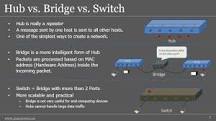You are using an out of date browser. It may not display this or other websites correctly.
You should upgrade or use an alternative browser.
You should upgrade or use an alternative browser.
Bridge or not bridge?
- Thread starter Olndo Pindaro
- Start date
drinkingbird
Part of the Furniture
Bridging is not switching. Bridging is linking 2 L2 segments together which is different. Bridging is much slower than switching.
It should have been posted over in the ASUS area.
Please do some googling.
A switch is a multi port bridge.
Switching and bridging are the exact same thing.
I googled.
What does a Layer 2 bridge do?
Layer-2 bridging works by putting one physical and one virtual Ethernet adapter into a mode where they can receive traffic that is not destined for their address. This traffic is selectively sent onto the other network according to the IEEE 802.1D standard, known as, "bridging" the frames.
What does a Layer 2 bridge do?
Layer-2 bridging works by putting one physical and one virtual Ethernet adapter into a mode where they can receive traffic that is not destined for their address. This traffic is selectively sent onto the other network according to the IEEE 802.1D standard, known as, "bridging" the frames.
drinkingbird
Part of the Furniture
I googled.
What does a Layer 2 bridge do?
Layer-2 bridging works by putting one physical and one virtual Ethernet adapter into a mode where they can receive traffic that is not destined for their address. This traffic is selectively sent onto the other network according to the IEEE 802.1D standard, known as, "bridging" the frames.
Yup, exactly. Put multiple bridges in the same package, and you have a switch.
In very old days bridges were often used exclusively to connect disparate network types and then hubs were used for the LAN (for cost reasons, bridges with dozens/hundreds of ports weren't feasible), which is where some of the confusion still comes from. A switch is just adding bridging technology to a hub. It can bridge the same type of connection, or different types, that's where SFPs or switches with multiple interface types come into play.
No, a bridge connects two L2 networks together. A switch connects altogether 1 L2 network.
What is the difference between Layer 2 switch and bridge?

Bridges connect two networks. Switches connect multiple clients to a network. Bridges operate at Layer 2 of the OSI communication model. Switches operate at Layer 2, the data-link layer, or Layer 3, the network layer.
What is the difference between Layer 2 switch and bridge?
Bridges connect two networks. Switches connect multiple clients to a network. Bridges operate at Layer 2 of the OSI communication model. Switches operate at Layer 2, the data-link layer, or Layer 3, the network layer.
drinkingbird
Part of the Furniture
No, a bridge connects two L2 networks together. A switch connects altogether 1 L2 network.
What is the difference between Layer 2 switch and bridge?

Bridges connect two networks. Switches connect multiple clients to a network. Bridges operate at Layer 2 of the OSI communication model. Switches operate at Layer 2, the data-link layer, or Layer 3, the network layer.
Keep saying no all you want. Doesn't change the facts. Not arguing it any further, I've been a network engineer for 23 years. You even confirm it right in your post saying they are both layer 2, but whatever.
You can't figure out the difference between 2 L2 networks and one L2 network. I can't help you. Study.Keep saying no all you want. Doesn't change the facts. Not arguing it any further, I've been a network engineer for 23 years. You even confirm it right in your post saying they are both layer 2, but whatever.
ColinTaylor
Part of the Furniture
@drinkingbird @coxhaus None of this is relevant to the OP's question. If you two want to argue the differences between a bridge and a switch please do it a private conversation.
drinkingbird
Part of the Furniture
@drinkingbird @coxhaus None of this is relevant to the OP's question. If you two want to argue the differences between a bridge and a switch please do it a private conversation.
There's no difference so nothing to argue
It is relevant though as he's saying OP should use dual router/NAT since it performs better than bridging. Obviously not the case.
drinkingbird
Part of the Furniture
In case anyone comes here in the future and is confused and cares to learn:

 www.snbforums.com
www.snbforums.com

Tutorial - Repeaters vs Bridges vs Routers
TL;DR - If it's TL, then DR! Since there has been some confusion recently, figured I'd post a high/medium level summary for any that are interested in knowing more about the differences and networking technology in general. The further up you go in the "layers" of the OSI model, the more...
Similar threads
- Replies
- 11
- Views
- 801
- Replies
- 0
- Views
- 437
- Replies
- 11
- Views
- 1K
- Replies
- 43
- Views
- 7K
Latest threads
-
-
-
GT-BE98 Pro Loses DNS with stock or merlin fw
- Started by revo770
- Replies: 0
-
-
Network Optimization for PUBG Mobile / iPad Pro M4 / ASUS Merlin
- Started by Vint87
- Replies: 0
Support SNBForums w/ Amazon
If you'd like to support SNBForums, just use this link and buy anything on Amazon. Thanks!
Sign Up For SNBForums Daily Digest
Get an update of what's new every day delivered to your mailbox. Sign up here!
